FAQ > Car, Truck and SUV Rear View Mirrors
•
My
car
has
a
rear
view
mirror
that
looks
very
complicated,
Is
it
going
to
be
an
issue
when
I
have
Phoenix
Glass
replaces my windshield?
Rear
view
mirrors
in
today
vehicles
do
appear
to
be
something
to
be
afraid
of
and
some
are
but
in
reality,
the
majority
of
them
are
just
business
as
usual
for
the
technicians
at
Phoenix
Glass.
There
are
a
few
out
there
that
can
be
rather
difficult
to
transfer
over
to
the
new
windshield
such
as
Infinity,
Lexus,
BMW
and
a
few
other
makes.
Unfortunately
for
that
simple
reason
it
puts
some
vehicles
into
the
difficult
installations
category
in
which
we
would
rather
not
perform
the
installation
in
the
field.
These
types
of
rear
view
mirrors
use
a
horse
shoe
shaped
spring
that
maintains
an
equal
pressure
on
each
of
the
two
ball
bearings
to
retain
the
mirror
to
the
mounting
bracket.
It's
not
at
all
uncommon
for
a
technician
to
have
difficulty
with
these
type
of
units
in
that
it
will
pop
apart
and
the
small
BB
sized
ball
bearings
exit
the
mirror
in
an
unsafe,
unruly,
flying
formation.
Imagine
trying
to
find
something
smaller
than
a
BB
in
a
parking
lot
or
worse
yet
a
gravel parking lot.
99% of the new windshields of today come from the factory with the rear view mirror mounting bracket already mounted on the
windshield.
•
My Rear View Mirror fell off my windshield, Can Phoenix Glass reattach it for me?
No
problem,
and
we
can
usually
do
it
while
you
wait
and
you
will
also
receive
a
life
time
warranty
for
the
work.
In
the
unlikely
event
of
it falling off again we'll put it back on for free for as long as you own the vehicle.
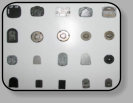
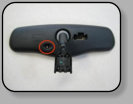
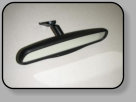

Ford Rear View Mirror

Examples of 20 different rear view
mirror mounting brackets

An Interpretation of the Standard:
Passenger
vehicles
must
have
an
inside
mirror
along
with
a
driver’s
side
mirror for rear viewin
g.
Federal
Motor
Vehicle
Safety
Standard
111
is
a
specification
pertaining
to
the
rear
vision
parts
of
a
vehicle.
This
federal
standard
outlines
important
safety
requirements
as
it
relates
to
automotive
mirrors.
FMVSS
111
specifies
the
required
range
of
vision
that
the
driver
must
achieve
utilizing
rear
vision
products.
These
ranges
are
both
horizontal
and
vertical
angles
from
the
side
and
rear
of
the
vehicle.
In
addition,
FMVSS
111
states
that
rear
vision
products
shall
have
an
average
reflectance
of
at
least
35
percent
(OEM
mirrors
are
typically
between
40%
and
60%
reflective).
This
part
of
the
specification
is
achieved
through
the
use
of
special
first
surface chrome glass.
Federal Motor Vehicle Safety Standard (FMVSS-111)
The
key
function
for
rearview
mirrors
is
to
maximize
the
field
of
vision
of
the
area
behind
the
driver.
The
convex
mirror
was
designed
to
increase
that
field
of
view.
The
federal
law
does
not
specifically
dictate
usage
of
convex
mirror
for
passenger
side
viewing;
however,
to
be
on
the
safe
side,
if
a
convex
mirror
part
was
originally
used
then
convex
mirror
should
be
reinstalled
to
maintain
the
maximum
field
of vision.
The
passenger
side
mirror
is
optional
as
long
as
there
is
a
field
of
vision
from
using
an
inside
rearview
mirror.
It
can
be
flat
or
convex
and
if
it
is
a
convex
mirror,
the
insignia
“Objects
are
closer
than
they
appear”
must
be
inscribed on the mirror.
If
viewing
from
an
inside
mirror
is
impossible,
an
example
of
this
would
be
one
of
our
Phoenix
Glass
Mobile
Installation vans, the vehicle must have a passenger side mirror along with a driver’s side mirror
.
If
there
was
a
convex
part
on
the
vehicle
originally,
it
should
be
replaced
with
a
convex
part
etched
with
the
proper
“OBJECTS
IN
MIRROR ARE CLOSER THAN THEY APPEAR” statement.
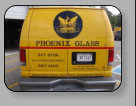
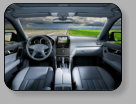


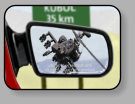
•
My Car doesn’t have a side view mirror on the passenger’s side, isn’t it supposed to?
•
What are the requirements for Rear and Side view Mirrors in Vehicles?
The passenger side mirror is optional as long as there is a field of vision from using an inside rearview mirror.
Requirements very depending on what type of vehicle you have, below you’ll find the Federal Motor Vehicle Safety Standard that applies
to just about all Vehicles.

•
One
of
my
side
view
mirrors
on
my
car
has
a
crack
in
it.
Can
I
just
have
the
glass
replaced
or
do
I
have
to
buy
an
entire unit?
An
Electrochromic
Mirror
is
a
mirror
that
electronically
automatically
dims
to
a
darker
color
when
it
is
subjected
to
bright
light
such
as
headlights
from
the
vehicles
behind
you.
The
reason
we
ask
this
question
is
the
vehicle
will
use
a
different
Windshield
if
it
has
one.
In
some
cases
the
vehicles
black
matrix band may be different and in others it may be as simple as a different mirror mounting bracket.
In
most
cases,
depending
on
your
particular
vehicle
we
can
replace
just
the
glass
but
there
are
a
few
out
there
that
will
require
the
entire mirror unit be replaced. Stop by our Service Center and we will be able tell you what options are available to you.
The
second
type
is
an
Automatic
Dimming
Mirror.
It’s
the
more
modern
of
the
two
and
is
called
an
Electrochromic
mirror.
Do
to
it’s
higher
cost
this
type
of
mirror
was
typically
only
found
in
today’s
higher
end
vehicles
but
in
the
past
few
years
we
seen
them
in
a
variety
of
different
models.
It
works
automatically
through
what
the
automotive
industry
refers
to
as
Electrochromism.
Sensors
which
are
located
on
both
the
front
and
rear
of
the
mirror
detect
the
level
of
light
coming
from
the
front
as
well
as
the
rear
of
the
the
vehicle.
The
Sensors
are
programmed
to
detect
night
driving
conditions
and
focuses
on
areas
of
light
intensity
that
may
prove
to
be
a
problem
for
drivers.
When
the
sensors
detect
light
they
send
an
electronic
signal
along
with
the
proper
voltage
level
to
the
mirror
activating
the solution that is sandwiched between two layers of glass to darken.
•
When
I
called
Phoenix
Glass
to
obtain
a
price
on
a
new
Windshield
for
my
car
your
CSR
asked
if
it
had
an
Electrochromic
Rear
View
Mirror.
What
is
an
Electrochromic
Rear View Mirror?
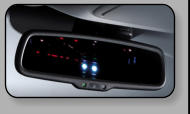
In
an
effort
to
help
overcome
this
problem,
two
different
types
of
interior
dimming
mirrors
have
been
created.
The
first
is
the
traditional
manually
operated
day/night
mirror.
This
is
the
one
you
are
most
likely
to
be
familiar
with,
it
works
with
a
manually
operated
flip
tab
located
in
the
bottom
center
of
the
rear
view
mirror.
You
flip
the
tab
and
it
adjusts
the
mirror’s
angle
to
a
light
dimming
reflection.
This
is
actually
the
result
of
using
two
different
reflective
surfaces,
one
on
the
front
of
the
mirror
and
one
on
the
back.
The
reflective
surface
on
the
back
is
lined
with
a
silver
derivative
material
that
makes
it
very
reflective,
while
the
front
of
the
mirror
is
normal
glass
only
slightly
reflective.
This
entire
piece
of
glass
is
actually
a
wedge
shaped
piece
of
glass
formed
to
a
particular
angle.
When
the
tab
on
the
mirror
is
set
in
the
Normal
position,
it’s
positioned
so
the
backside
of
the
mirror
reflects
the
road,
but
when
flipped
up
into
it’s
night
time
mode
the
normal
glass
in
front
handles
the
reflection,
returning
a
much
dimmer
version
of
the
road.
The
lesser
reflecting
capabilities of the normal glass will help protect your eyes from bright light effects behind them.
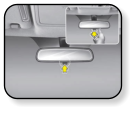
Most
people
think
the
interior
dimming
rear
view
mirror
is
just
another
gadget
the
auto
makers
came
up
with
as
a
customer
convenience
but
they
were
actually
developed
as
a
result
of
the
many
accidents
that
are
caused
from
a
visual
effect
known
as
The
Troxler
fading
effect.
The
Troxler
fading
affect
is
a
phenomenon
that
occurs
when
you
try
to
focus
your
vision
on
a
single
point
in
space
for
more
than
20
seconds.
When
you
do
this
it
will
create
a
stimulus
outside
the
range
of
your
focal
point
to
fade
away.
To
see
an
example
of
this
effect
click
on
the
photo
on
your
right
and
then
try
focusing
on
the
red
dot
in
the
center
of
the
picture
for
10-15
seconds
and
you
will
see
that
the
blue
circle
will
disappear.
T
his
momentary
blindness
or
obscurity
can
cause
problems
for
drivers
d
riving
at
night
or
in
dark
conditions
because
The
Troxler
fading
effect
happens
automatically
when
your
eyes
are
exposed
to
bright
lights,
be
it
from
your
rear
or
side
view
mirrors,
(typically
both)
on
coming
traffic
or
even
street
lights.
This
happens
even
quicker
when
your
driving
in
rural
areas.
where
it’s
very
dark.
When
your
eyes
are
exposed
to
bright
lights
your
eyes
immediately
compensate
by
tuning
out
distractions
so
you
can
focus
on
particular
things.
Unfortunately,
after
the
bright
light
disappears
your
eyes
take
time
to
readjust
to
low
light
conditions,
especially
when
you're
trying
to
look
in
a
particular
direction.
The
continual
distraction
of
bright
lights
from
behind
the
driver
can
be
even
worse
when
reflected
in
the
rear
view
mirrors
causing
the
eyes
to
slowly
lose
sight
of
road
details
in
front
of
the
car.
To
reveal
the
effects
of
glare
on
the
eyes
that
drivers
must
endure
studies
that
have
been
conducted
have
shown
that
The
Troxler
fading
effect
increases
driver
reaction
time
by
up
to
1.4
seconds.
This
means
that
when
traveling
at
night
or
in
dark
conditions
at
60
mph,
it
would
take
you
1.4
seconds
which
translates
to
123
feet
more
than
normal
before
you would be able to see again and be able to react to road hazards.
•
My
Cars
inside
rear
view
mirror
is
broken
and
I’ve
found
that
it
is
very
expensive
to
have
the
whole
unit
replaced.
I
understand
I’ll
loose
the
dimming
capability
of
the
mirror
but
can
Phoenix
Glass
custom
cut
a
normal
type
of
mirror
to fit it?.
That’s
a
simple
question
we’re
asked
almost
on
a
daily
basis
but
the
answer
isn’t
so
simple.
Let
us
start
out
with
Yes
we
Can
but
we’re
sorry
to
say
we
Won’t.
Long
ago
it
was
done
with
both
rear
and
side
view
mirrors
on
a
regular
basis
and
considered
business
as
usual
because
the
majority
of
people
didn’t
know
any
better
and
as
much
as
we
hate
to
say
it,
some
still
don’t.
The
mirror
glass
that
was
used
is
the
same
type
of
1/8th
inch
thickness
mirror
glass
that
you
see
everyday
in
your
typical
bath
room
medicine
cabinet
mirror.
In
that
type
of
situation
it
does
a
fantastic
job
but
in
an
automotive
application
it
can
literally
cost
you
your
life.
When
this
type
of
mirror
is
used
in
an
automotive
application
the
reflection
it
gives
you
is
far
to
bright
in
dark
night
time
driving
conditions.
When
the
bright
light
enters
your
eyes
it
causes
a
little
known
phenomenon
called
The
Troxler
Fading
Effect
that
can
literally
make
objects
disappear
before
your very eyes.
•
What is the Troxler Fading Effect and how does it effect my night driving?
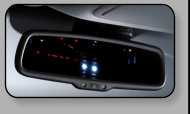



Copyright 2013 © Phoenix Glass, Inc. All Rights Reserved
Revised June 2023
Please Like Us
on Facebook














